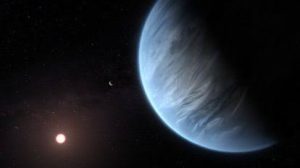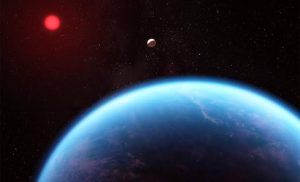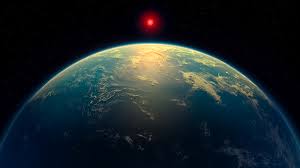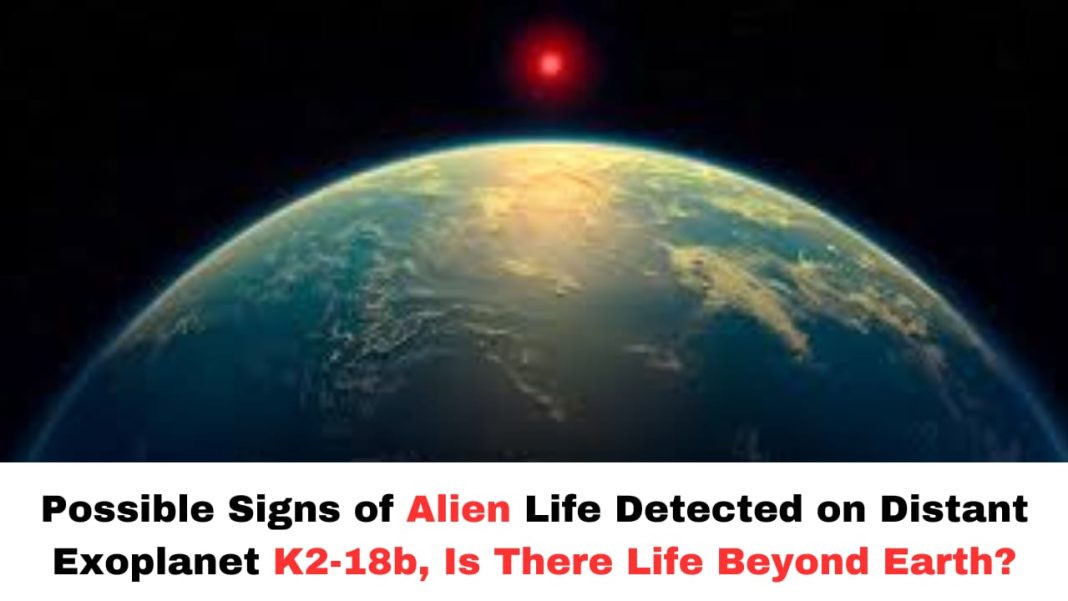Digital News Guru National Desk:
Potential Signs of Life Detected on Exoplanet K2-18b
In a groundbreaking development, astronomers have identified potential chemical indicators of life on the exoplanet K2-18b, situated approximately 124 light-years away in the constellation Leo. Utilizing data from the James Webb Space Telescope (JWST), researchers have detected molecules in the planet’s atmosphere that, on Earth, are predominantly associated with biological processes.
Understanding K2-18b: A Hycean World
K2-18b is classified as a “Hycean” exoplanet—a term describing planets that are larger than Earth but smaller than Neptune, characterized by a hydrogen-rich atmosphere and a possible global ocean beneath. With a radius about 2.6 times that of Earth and a mass over eight times greater, K2-18b orbits within the habitable zone of its red dwarf star, K2-18, where conditions might allow for the presence of liquid water.

Chemical Signatures Suggesting Biological Activity
Recent spectroscopic observations from JWST have revealed the presence of several molecules in K2-18b’s atmosphere:
- Methane (CH₄) and Carbon Dioxide (CO₂): These carbon-bearing molecules were detected with high confidence. Their abundance, coupled with the non-detection of ammonia (NH₃), aligns with models predicting a hydrogen-rich atmosphere overlaying a liquid water ocean.
- Dimethyl Sulfide (DMS) and Dimethyl Disulfide (DMDS): Tentative signs of these sulfur-containing compounds were identified. On Earth, DMS is primarily produced by marine microorganisms, such as phytoplankton. The detection of these molecules at a 3-sigma confidence level suggests a 99.7% probability that the signal is real, though further observations are necessary to confirm their presence and rule out non-biological sources.
Scientific Caution and the Need for Further Research
While the detection of DMS and DMDS is intriguing, scientists urge caution in interpreting these findings:
- Statistical Significance: A 3-sigma detection is considered suggestive but not definitive. The gold standard for confirmation in such studies is a 5-sigma detection, corresponding to a 99.99994% confidence level.
- Potential Abiotic Sources: Although DMS is typically associated with biological activity on Earth, recent studies have indicated that it can also form through non-biological processes, such as in cometary matter. This highlights the importance of considering alternative explanations for its presence on K2-18b.

- Instrumental Limitations: The current instruments aboard JWST have limitations in distinguishing between overlapping molecular signals. Future observations with more advanced instruments are planned to improve the accuracy of these detections.
Implications for the Search for Extraterrestrial Life
The potential discovery of biosignature gases on K2-18b represents a significant milestone in the search for life beyond Earth. If confirmed, it would suggest that life could exist in environments vastly different from our own, expanding the scope of habitable conditions in the universe.
However, the scientific community emphasizes the need for rigorous validation of these findings. As Dr. Nikku Madhusudhan, the lead researcher from the University of Cambridge, stated, “Extraordinary claims require extraordinary evidence.” The team plans to conduct additional observations and analyses to confirm the presence of these molecules and explore their origins.
Future Prospects and Missions
The detection of potential biosignatures on K2-18b has spurred interest in further exploration of Hycean worlds. Upcoming missions and telescopes, such as the European Space Agency’s ARIEL mission, aim to study the atmospheres of exoplanets in greater detail, enhancing our understanding of their composition and potential habitability.
Moreover, the continued development of more sensitive instruments will enable astronomers to detect and analyze faint molecular signals with higher precision, bringing us closer to answering the age-old question: Are we alone in the universe?
Conclusion
Exoplanet K2-18b: Located 124 light-years away in the constellation Leo, K2-18b is a sub-Neptune-sized planet situated within the habitable zone of its red dwarf star. This positioning suggests conditions that could support liquid water.

Detection of Potential Biosignature Gases: Using the James Webb Space Telescope (JWST), researchers identified dimethyl sulfide (DMS) and dimethyl disulfide (DMDS) in the planet’s atmosphere.On Earth, these compounds are primarily produced by marine microorganisms like phytoplankton.
Statistical Confidence: The presence of these compounds was observed with a statistical significance of approximately 3-sigma, indicating a 99.7% confidence level. While this is a strong indication, it’s not definitive proof of life.
You May Also Read: Pharma Live Expo 2025 Begins in Mumbai: A Confluence of Innovation and Collaboration in the Pharmaceutical Industry








